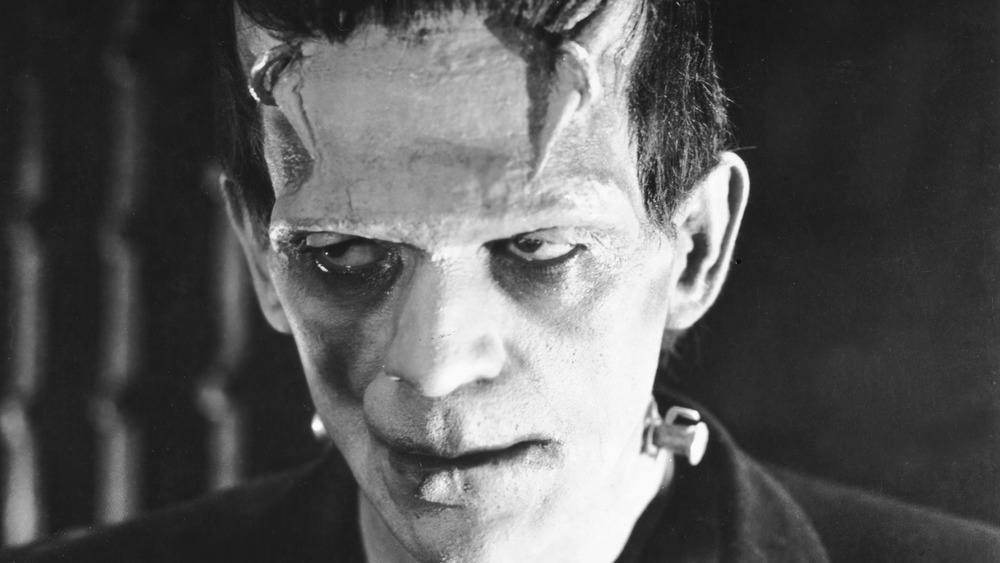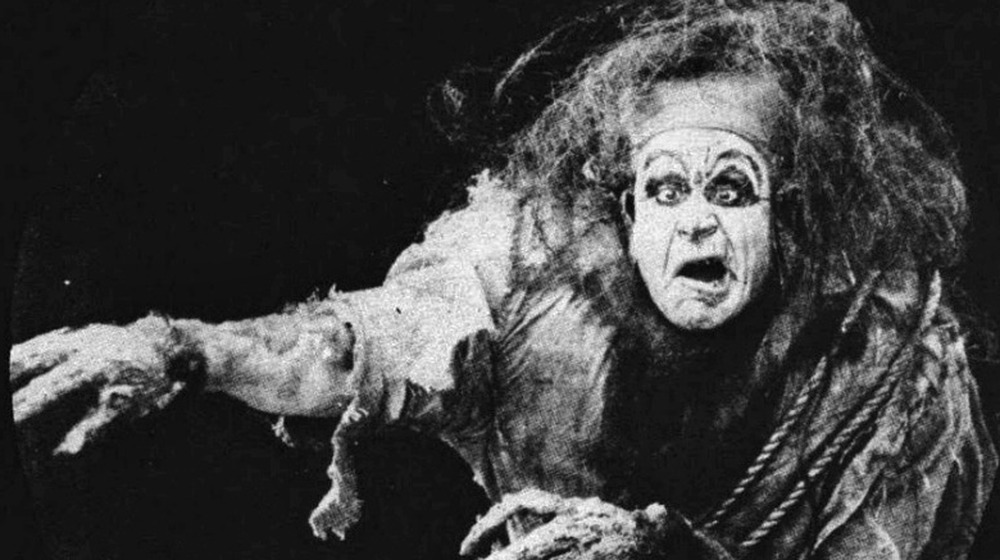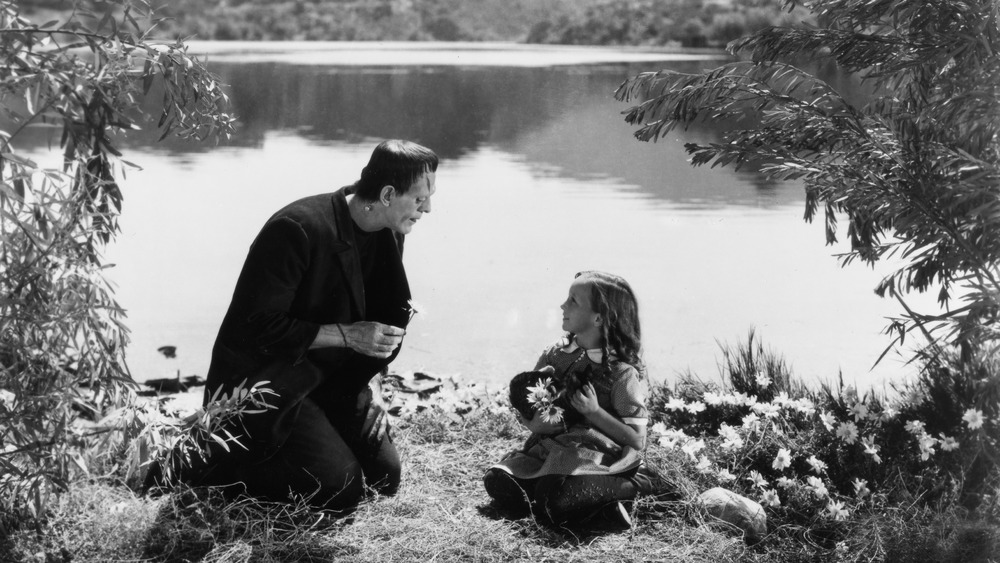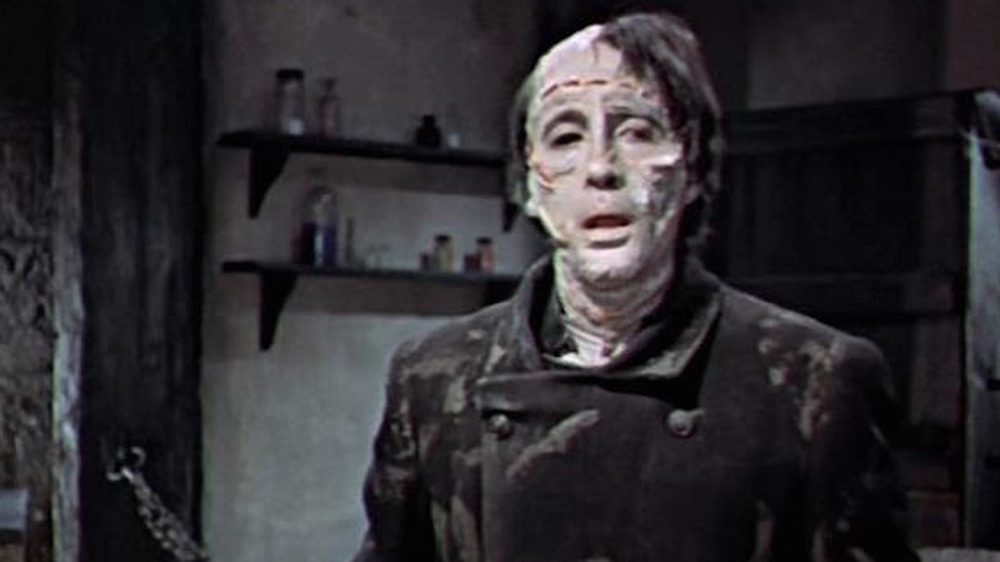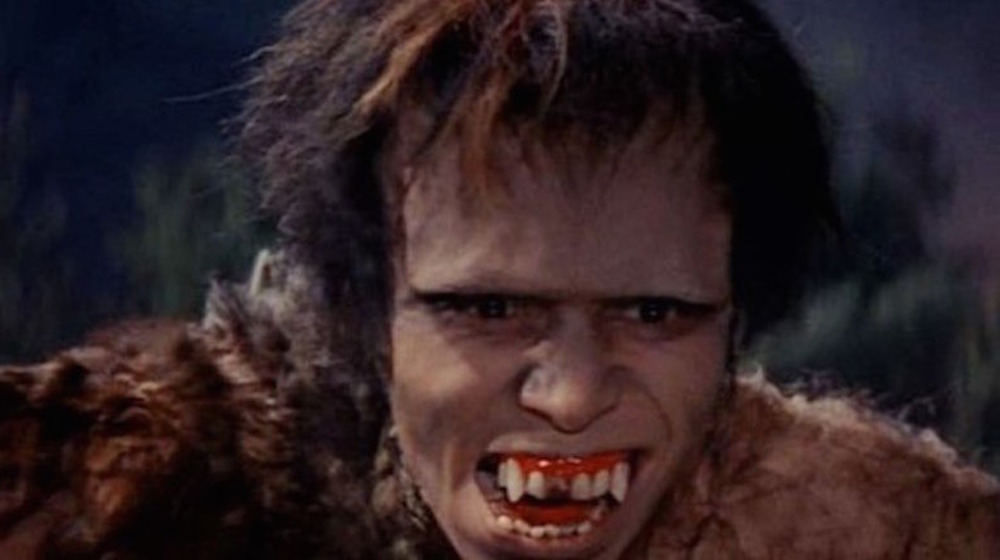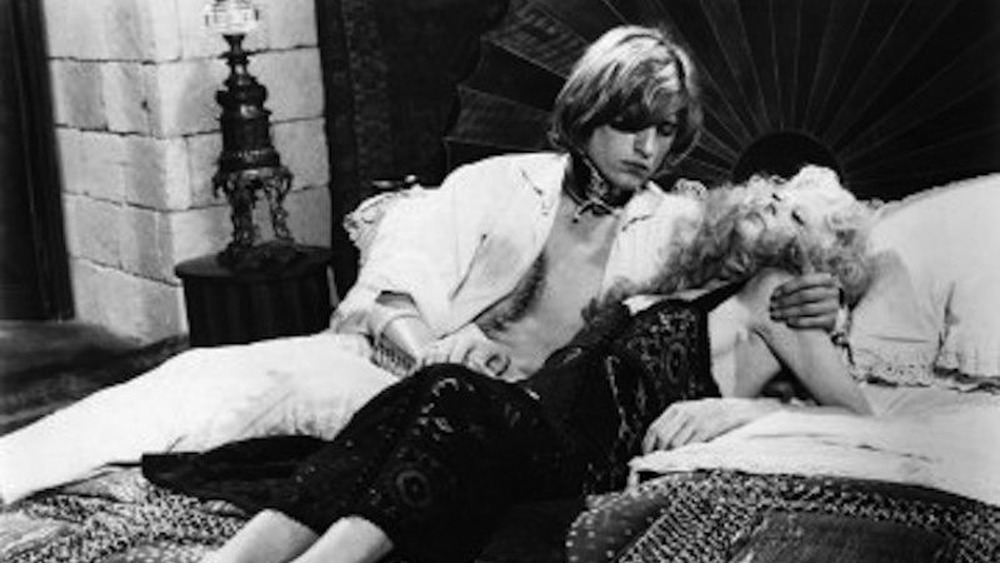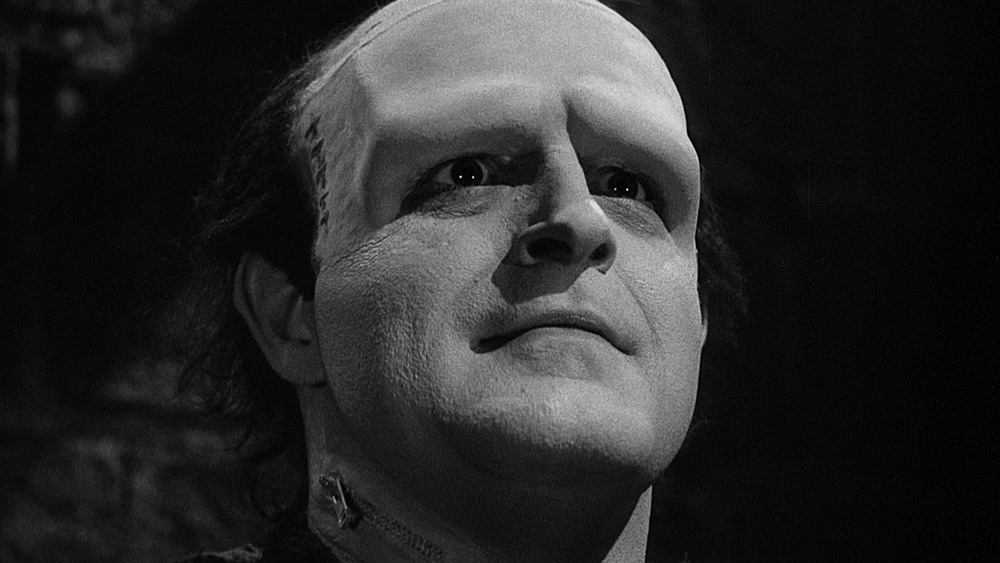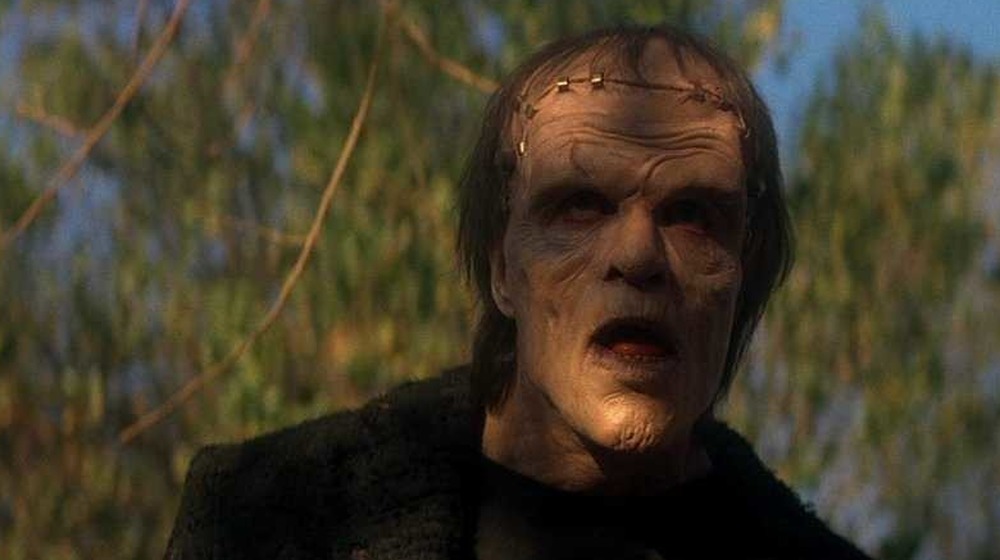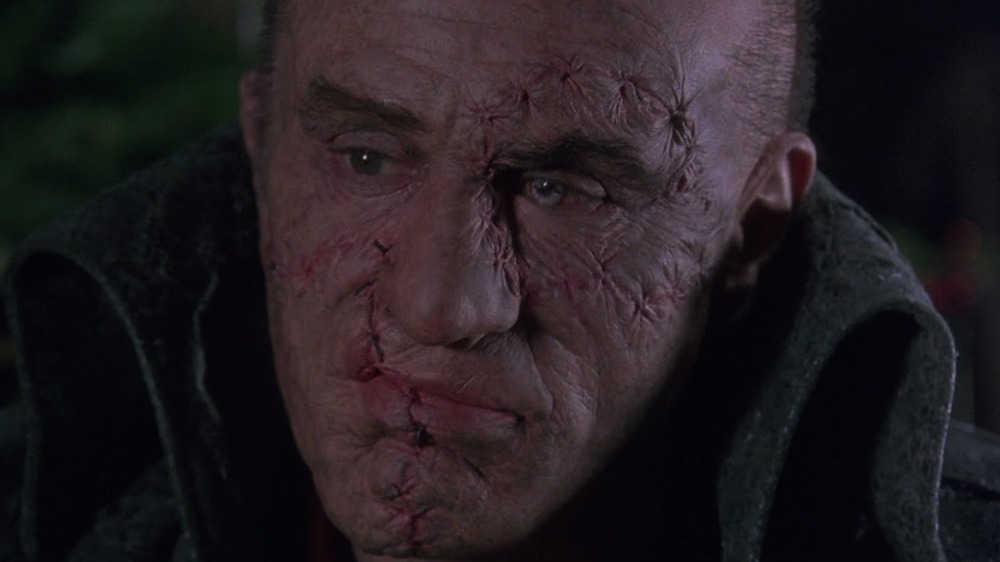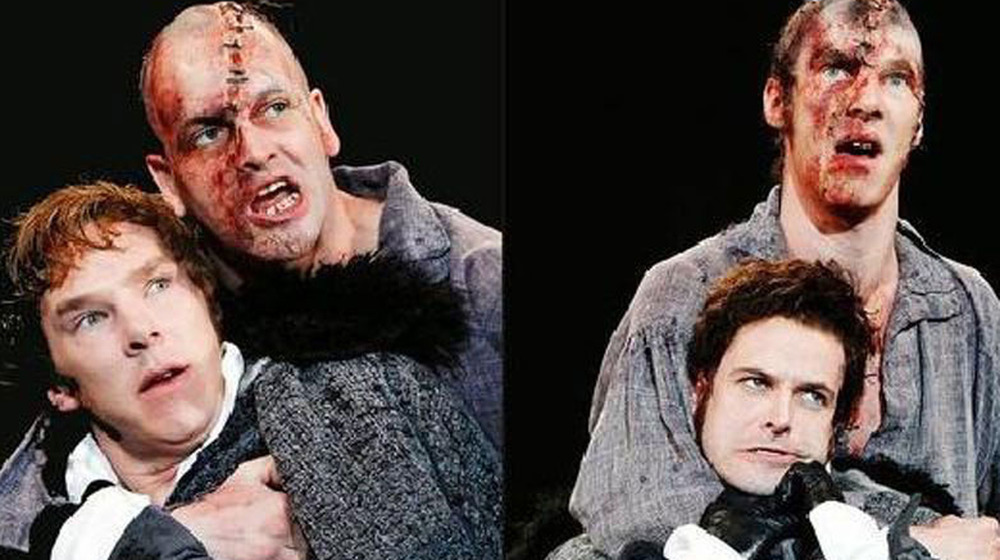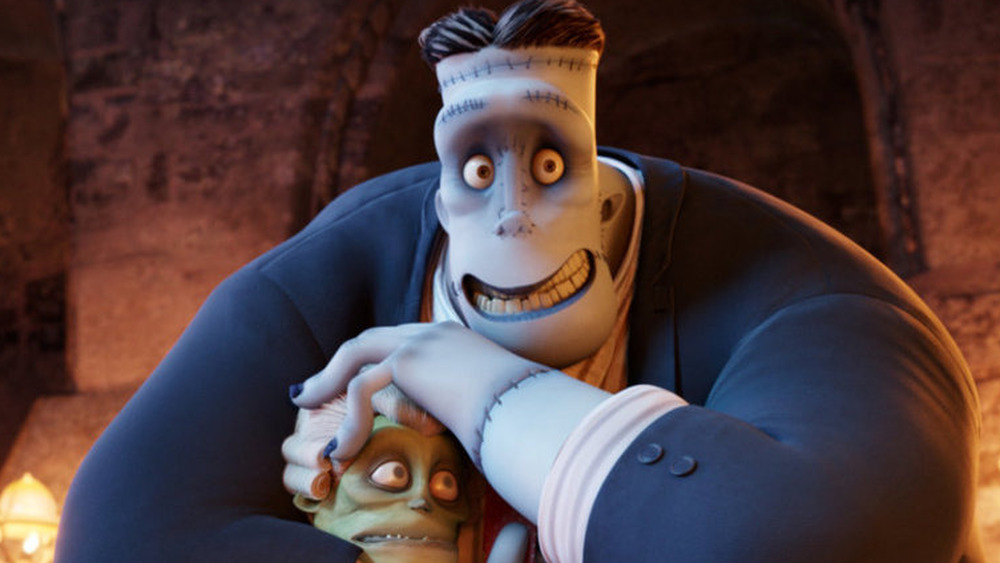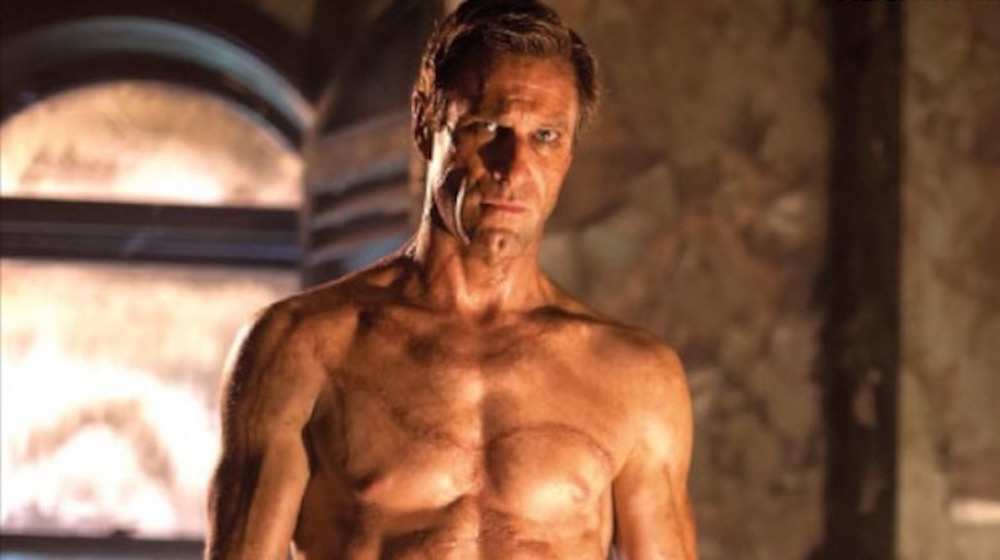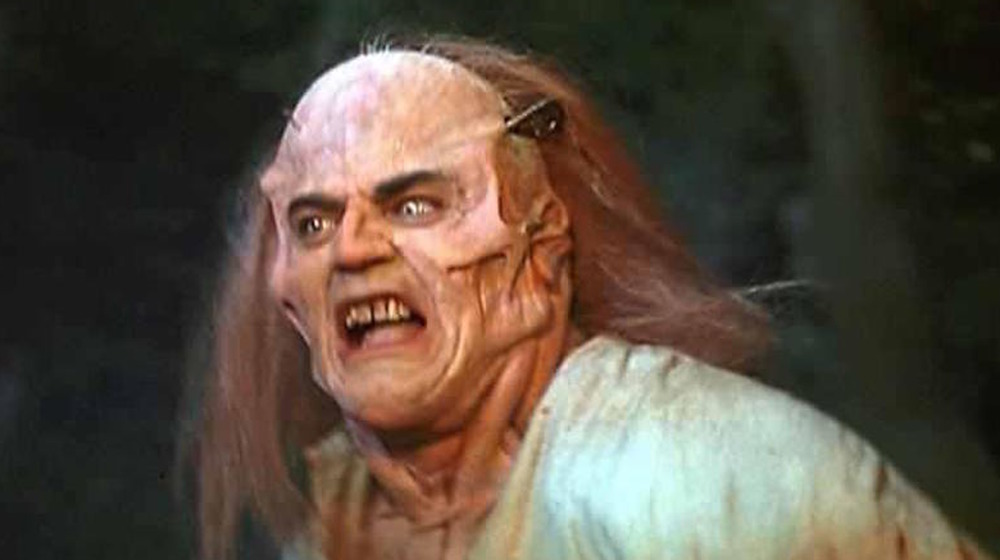The Many Faces Of The Frankenstein Monster In The Movies
In Mary Shelley's 1818 novel Frankenstein; or, the Modern Prometheus, the description of the Monster is relegated to just a few lines. He possesses yellow skin, watery eyes, and "lustrous black" hair. That relatively brief sketch may have been intended to allow readers to craft their own image of the creature, but it's also given free rein to interpretations of the Monster in film, television, on the stage, and in other media.
There have been ferocious and kind-hearted Monsters, silent beings and ones blessed with eloquent voices, teenaged Monsters, female Monsters, Italian, Japanese, Swedish, and Mexican Monsters, and even Monsters that sing, dance, and shill breakfast cereal. Actors that have taken on the role of the creature range from Star Wars vets Christopher Lee and David Prowse to Robert De Niro, Benedict Cumberbatch, and even Will Ferrell — whose Monster, as seen on an episode of Drunk History, is one of the few that actually resembles Mary Shelley's creature.
What follows is a list of Frankenstein Monsters seen in movies over the past 100 years. No TV takes here, so you won't find Rory Kinnear's terrific portrayal from Penny Dreadful. Some of these Monsters may be familiar to you, while others might be totally new. In all cases, please note that spoilers are likely.
Meet Charles Ogle, film's first Frankenstein Monster
Many moviegoers think Boris Karloff is the first screen interpretation of the Monster, but another actor beat him to the punch by two decades. Charles Stanton Ogle, an Ohio-born actor with numerous credits during the silent era, was the first to portray the Monster on-screen in the Thomas Edison-produced 1910 silent short, Frankenstein. It is described in its title card as a "liberal adaptation," but it does a remarkably decent job of boiling down the major plot points of the novel.
Directed by J. Searle Dawley, this adaptation focuses largely on Augustus Phillips' Frankenstein, whose hubris in attempting to create a perfect human results in a horrible creation (Ogle) that attempts to ruin his life and relationship with fiancée Elizabeth (Mary Fuller). Ogle's Monster cuts a striking figure that borrows from Shelley's description –- the tremendous strength and "flowing" hair –- while adding Kabuki-like makeup, a leering face, and medieval-styled garb. Ogle's portrayal is theatrical, though not out of place for silent film standards, and leans on the menacing aspects of the Monster, save for his final scene. Having been rejected by Frankenstein, the Monster catches a glimpse of his own hideous appearance in a mirror. Stricken with horror, he disappears. Despite the technical limitations of the film and Ogle's broad turn, this moment injects a note of sympathy that would be echoed by many of the actors who have assumed the Monster's mantle in the ensuing years.
Boris Karloff, king of the Monsters
Dozens of actors have played the Monster over the past century, but few, if any, have made such an indelible mark with their performance as British actor Boris Karloff did in 1931's Frankenstein. In his hands, the Monster is a startling figure, an aspect enhanced by Jack P. Pierce's iconic makeup. But he is also a child-like one, as evidenced by the scene in which the Monster reacts to his first glimpse of sunlight in Frankenstein's laboratory. That innocence, combined with raw brute strength that he can't properly wield or even comprehend, turns to horror in the still-shocking sequence in which the Monster accidentally drowns the shepherd's daughter.
That mix of terror and sadness, expertly captured by director James Whale, made Frankenstein a hit and Karloff a star: He would play the Monster two more times, in the equally memorable Bride of Frankenstein (1935) and the underrated Son of Frankenstein (1939), before turning over the Monster to other actors, including fellow Universal horror stars Bela Lugosi and Lon Chaney Jr. His performance has defined depictions of the Monster for decades, evident in everything from Bobby "Boris" Pickett's hit single "Monster Mash" to General Mills' Frankenberry cereal to Phil Hartman's recurring turn as a monosyllabic Monster on Saturday Night Live.
Christopher Lee launches his horror career as the Monster
Christopher Lee had been a hardworking if largely anonymous actor in films and on television for a half-decade before Hammer Film Productions approached him to play the Monster opposite Peter Cushing in 1957's The Curse of Frankenstein. At 6'5", Lee was a natural to play the role, but his physicality wasn't the only element he brought to the creature. As Lee noted in his autobiography, Lord of Misrule, playing "a being who was neither oneself nor anybody else," given his construction from pieces of other people, was something of an existential challenge. He tackled it by playing the monster as somewhat lost and lacking control of his own body: "I decided that my hands must have an independent life," he wrote, "and that my movements must be sudden and unbalanced." Playing the Monster not only gave Lee appreciation for his most famous predecessor in the role, Boris Karloff — who was his friend and neighbor in London –- but also a path to international stardom. Lee's journey began with Hammer films like Horror of Dracula and grew to include both the Star Wars and Lord of the Rings franchises.
Frankenstein Conquers the World (but starts in Japan)
Japan's Toho Films had been trying to pit the Monster against its stable of kaiju since the early 1960s. As Japanese fantasy historian August Ragone has noted, movies setting the Monster up against Godzilla, King Kong, and even the Human Vapor were considered before the company partnered with producer-distributor Henry G. Saperstein for Frankenstein vs. Underground Monster Baragon, which was released stateside in 1965 as Frankenstein Conquers the World.
The film features one of the most bizarre origin stories for the Monster ever told: The heart of Frankenstein's creation is transported from Nazi Germany to Axis Japan and, after being saturated with radiation from the atomic blast at Hiroshima, grows into an entirely new being. This Monster is a feral boy (played by actor Koji Furuhata) with an appetite for devouring live animals. After reaching a height of 60-plus feet, the Monster breaks loose and runs free until he encounters the subterranean dinosaur Baragon, who also happens to be conducting a reign of terror in Japan. Furuhata's turn as the Monster marked his only appearance in a Toho film, though 1966's War of the Gargantuas serves as a sequel of sorts. Its twin monsters are credited as cellular relatives of the Monster in the Japanese and international edits, though the American cut removes all mention of Frankenstein.
He's the flesh part of Flesh for Frankenstein
There are multiple Monsters in director Paul Morrissey's gross-out Flesh for Frankenstein, which was released in the United States as Andy Warhol's Frankenstein (though the artist's contribution to the film was minimal at best). Cult favorite Udo Kier, playing a thoroughly unhinged Baron Frankenstein, builds male and female creatures with the intent of creating a master Serbian race. However, he is forced to take the former back to the drawing board after noting his difficulties in the procreation department. With the help of his equally out-to-lunch assistant (Arno Juerging), the Baron waylays would-be seminary student Sacha (Srdjan Zelenovic) and lops off his head to serve as the Monster's new dome.
However, the upgrade does nothing for the Monster's bedroom urges, though the Baron's sister-wife (Monique van Vooren) does manage to turn the creature's (severed) head. As the male Monster, Zelenovic is required to do very little other than look blank and attractive in various states of undress until the film's frenzied conclusion, in which he rescues his friend (Joe Dallesandro) from the Baron's clutches. The Monster then proceeds to ruefully and messily end his own life. Horrified and amused filmgoers who attended the film's premiere back in 1973 got to enjoy these scenes in gloppy, gory 3-D.
Peter Boyle played the funniest Monster ever in Young Frankenstein
The Monster has been featured in comedies as early as 1948, which saw the release of Abbott and Costello Meet Frankenstein. But historically, he was rarely given more to do than bumble or provide material for the main actors. Then came Mel Brooks' 1974 hit Young Frankenstein, which delivers a Monster who is not only funny, but also as strikingly innocent as Boris Karloff's creature.
Though the script by Brooks and star Gene Wilder outlines all of the absurdities that the Monster faces, much of the credit for the success of the performance is due to actor Peter Boyle. A versatile character actor and former member of the famed Second City improvisational troupe, Boyle had gained acclaim for playing intense figures like the violent blue-collar crank in Joe and the philosophical cabbie Wizard in Martin Scorsese's Taxi Driver. Boyle himself was the antithesis of these roles –- he was a former seminary student and antiwar activist –- and he brought this duality to the Monster, who is perceived as menacing but eventually proves to be sweet, erudite, and something of a ladies' man. In the film's most memorable scene, he further reveals himself to be an enthusiastic (if tone-deaf) song-and-dance performer.
Tom Noonan brings method to The Monster Squad
One of the most beloved elements of the 1987 cult horror favorite The Monster Squad is Tom Noonan's childlike turn as the Monster. Like Karloff, Lee, and Peter Boyle, Noonan's filmography features more than its share of menacing characters, including Francis Dolarhyde, the terrifying Tooth Fairy in Michael Mann's Manhunter, and villains in Robocop 2 and The Last Action Hero. But in Fred Dekker's film, Noonan tapped into the same wellspring of gentle wonder that fueled Karloff and Boyle's Monsters.
Many of the film's highlights are built around Noonan's interaction with the film's young stars, especially scenes with Ashley Bank's Phoebe, who recognizes the Monster as something of a kindred spirit and ideal playmate. To maintain that guileless quality, Noonan reportedly remained in character both on- and off-camera. This unnerved some of his castmates when they tried to engage with the actor, and were instead met with the Monster.
Robert De Niro saved Mary Shelley's Frakenstein
Critics have vented their spleens for years over 1994's Mary Shelley's Frankenstein. Principally, they lay the blame for its failure at the feet of director Kenneth Branagh, who plays Victor Frankenstein as a bare-chested hero, and a tone that hovers somewhere between overripe Gothic melodrama, Hammer horror, and unintentional comedy. Even co-producer Francis Ford Coppola and screenwriter Frank Darabont (The Walking Dead) have suggested or voiced their dislike for the film.
However, the Branagh Frankenstein does offer one of the best takes on the Monster around courtesy of Robert De Niro, who, at first blush, seems like a left-field choice for the role. De Niro, however, proves entirely on the money as Darabont's emotionally wounded Monster. Playing men who struggle to balance their stunted emotions, brutish words, and tremendous propensity for violence has been De Niro's stock in trade for decades (see Goodfellas, The Irishman, et al) — the Monster is squarely within his wheelhouse, despite the change in genre. Whether he's exacting horrible revenge on Branagh or weeping after being driven away from the family of Richard Briers' blind hermit -– the only person to show him any affection -– De Niro's Monster is both terrifying and tragic.
Benedict Cumberbatch and Jonny Lee Miller: Two Monsters for the price of one
Attendees of the National Theatre's 2011 production of Frankenstein were given an option: Did they want to see Benedict Cumberbatch (Avengers: Endgame) as the Monster and Jonny Lee Miller (Elementary) as his creator, or would they prefer them to reverse roles? The two leads alternated parts on opposing nights throughout the run of the production, which was directed by Oscar winner Danny Boyle (Slumdog Millionaire). The role switch is more than just a great gimmick: It also underscores the theme of Nick Dear's script, which suggests that the creature and scientist are two sides of the same coin. One man is corrupted by his desire for scientific glory, while the other is undone by his desire for companionship and acceptance.
The two-hour show was streamed live to movie theaters across the globe as part of the National Theatre Live program. It has since enjoyed several encore screenings, including a 2018 broadcast to celebrate the 200th anniversary of Mary Shelley's novel, and inclusion in the National Theatre at Home series, which brought theater to the masses during the COVID-19 pandemic.
An animated, amiable Monster in Hotel Transylvania
Following in the XXL footsteps of Peter Boyle, Fred Gwynne's Herman Munster, and others who have offered comic takes on the Monster, Kevin James provided the voice of the amiable Frank in Genndy Tartakovsky's 2012 animated feature Hotel Transylvania, and its two sequels. James' Monster serves as a sounding board and the voice of reason for Adam Sandler's Dracula, most notably regarding his anxiety over his daughter Mavis and later, his grandson Dennis. Between their hijinks, Frank also enjoys some good-natured sparring with his bride, Eunice, voiced with adenoidal gusto by Fran Drescher.
Frank is essentially an oversized version of the affable sidekick in almost every sitcom. Still, in Hotel Transylvania 2, he does have one decidedly traditional Monster moment when the platform holding him and pals Wayne the werewolf (Steve Buscemi) and Invisible Man Griffin (David Spade) topples and crashes, turning him into a bellowing fireball that wreaks total destruction on the cabins at a summer camp. Canadian actor Paul Braunstein voiced Frank in the Sony/Nelvana animated series.
Aaron Eckhart played a fit Monster in I, Frankenstein
"Universal loathing" is perhaps the most polite way to describe critical reaction to writer-director Stuart Beattie's 2014 adaptation of Kevin Grevioux's graphic novel, I, Frankenstein. The fault for the film's failure shouldn't lie with Aaron Eckhart, who played the movie's Monster. Eckhart brought as much gravitas and physicality to the creature as possible — he's arguably the most ripped Monster in movie history. But ultimately, Eckhart's talent and screen presence isn't enough to save him from being dragged down by the film's needlessly complicated plot, which throws the Monster into a centuries-long battle between gargoyles led by Miranda Otto and an army of demons under the command of Bill Nighy. The secondary monsters and their squabble eventually overwhelm the film to such a degree that the Monster and all he represents seems to be an afterthought: Adam could have easily been Highlander's Conor MacLeod, or even Selene from the Underworld series (also co-created by Grevioux), for all that his identity matters to the film.
Nick Brimble played an underdog Monster in Frankenstein Unbound
Roger Corman returned to the director's chair after a two-decade absence with this 1990 adaptation of Brian Aldiss' novel Frankenstein Unbound. It's a dizzying amalgam of Frankenstein myth, futuristic time travel, and rumination on the dangers of unchecked science, and as such, doesn't ever gel into a cohesive picture. But it does have some enjoyable elements. The cast is certainly impressive, including Raul Julia as Victor Frankenstein, Bridget Fonda and Jason Patric as Mary and Percy Shelley, respectively, and John Hurt as the film's hero, scientist Joe Buchanan. It also has decent special effects, and an amusing script by Corman and critic F.X. Feeney.
Its Monster, played by Nick Brimble, hews more towards the novel's aggrieved avenger than other adaptations do. Brimble's makeup is pretty outlandish -– New York Times critic Vincent Canby wrote that he looks like "[dancer-turned-actor] Alexander Godunov ... after a failed face-lift." But he possesses both the brawn and destructive capabilities of the classic movie Monsters, and the bruised emotion of Mary Shelley's creature. That's a lot more than many bigger-budgeted Frankensteins can claim.
